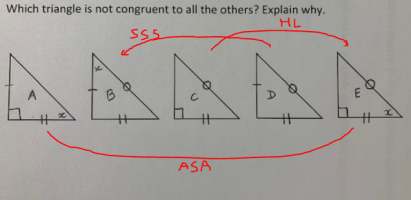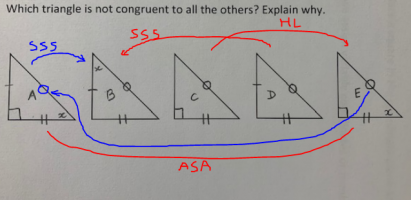pearl12970
New member
- Joined
- Oct 12, 2021
- Messages
- 6
Have you learned the theorems related to triangle congruence?Could you please help me with this question about congruent triangles? Would really appreciate it.
Please explain the notation. In particular, what does a circle on an edge mean? This is one of several things we would know if you had followed instructions and told us your thoughts about the problem:Could you please help me with this question about congruent triangles? Would really appreciate it.
Dr. Peterson, thank you so much for answering my question. My apologies for the confusion. My textbook uses the circle as one the ways to congruent sides.Please explain the notation. In particular, what does a circle on an edge mean? This is one of several things we would know if you had followed instructions and told us your thoughts about the problem:
READ BEFORE POSTING
Welcome to FreeMathHelp.com! Please take the time to read the following before you make your first post. It will help you to get your math questions answered promptly and in the most helpful manner. A summary is available here, but please read the complete guidelines below at your earliest...www.freemathhelp.com
Also, as drawn, all five triangles are congruent; presumably the question means to ask which one is not necessarily congruent to the others, based only on the markings. I'm not very happy with the statement of the problem!
But it's interesting that B and E are, respectively, D and C with an extra marking. This should be a useful clue (if it can be solved at all).
I have learned the theorems. SSS, SAS, ASA, AAS, HL.Have you learned the theorems related to triangle congruence?
What are those?
Sometimes, our teacher asks us questions where the answer is "no solution" so this is probably one of them, since all are congruent. Would really appreciate if you could please give me a hint for how C is congruent to D. I am not able to see which theorem applies to prove they are congruent.Please explain the notation. In particular, what does a circle on an edge mean? This is one of several things we would know if you had followed instructions and told us your thoughts about the problem:
READ BEFORE POSTING
Welcome to FreeMathHelp.com! Please take the time to read the following before you make your first post. It will help you to get your math questions answered promptly and in the most helpful manner. A summary is available here, but please read the complete guidelines below at your earliest...www.freemathhelp.com
Also, as drawn, all five triangles are congruent; presumably the question means to ask which one is not necessarily congruent to the others, based only on the markings. I'm not very happy with the statement of the problem!
But it's interesting that B and E are, respectively, D and C with an extra marking. This should be a useful clue (if it can be solved at all).
I too found this to be an extremely irritating question. About the [imath]\circ[/imath], some fifty years while visiting my wife on one of her art exchanges I saw that used to indicate a third side of two triangle being congruent(in Africa or India)Please explain the notation. In particular, what does a circle on an edge mean? This is one of several things we would know if you had followed instructions and told us your thoughts about the problem:
That’s correct. The circles indicate congruent sides. This question is straight out of a math textbook.As long as sides of two triangles are marked the same way, where it is "|" or "||" or "o" I would assume they are congruent.
I am sorry you found this irritating. This is from my math textbook. Now imagine how we students might feel!I too found this to be an extremely irritating question. About the [imath]\circ[/imath], some fifty years while visiting my wife on one of her art exchanges I saw that used to indicate a third side of two triangle being congruent(in Africa or India)
So in this case[imath]\Delta(B)\cong \Delta(D)\text{ by }SSS[/imath]. Likewise [imath]\Delta(A)\cong \Delta(E)\text{ by }ASA[/imath]
I truly hope that peral12970 will answer with come clarification.
The first thing we can say is that if any four are congruent, then all five are, because they form two groups of congruent triangles, A=C=E and B = D:Sometimes, our teacher asks us questions where the answer is "no solution" so this is probably one of them, since all are congruent. Would really appreciate if you could please give me a hint for how C is congruent to D. I am not able to see which theorem applies to prove they are congruent.


